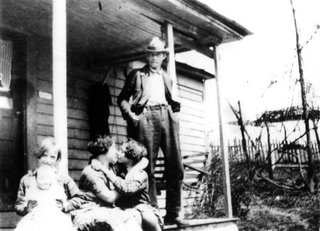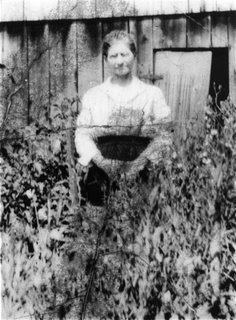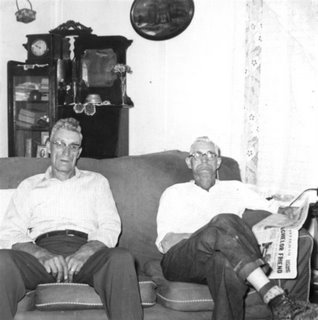 Hilary Blake
Hilary Blake
A family of musicians, the Ray and Nora (Blake) Hall family, lived below Emery Skinner’s farm, in a home owned by Erma Cosner. Ray was the son of Strange and Hestaline (Riffle) Hall and Nora was the daughter of John Jackson "Jack" and Ella Blake. The entire family played music. Among the children, Edna and Lawrence, known as “Bud,” played the banjo, Delis played the harmonica, and Mary played the guitar. My foster mother, Mrs. Holbert sent me to the Hall house each Saturday morning to take banjo lessons from Edna. Unfortunately, I only learned which end of the banjo to hold. -Nina (Smarr)by David Parmer and Loretta (Morrison) Roehrs
Two Views
"He was a very nice, likable fellow and seemed to be very happy," remembers
Loretta (Morrison) Roehrs about her mother's cousin
Hilary Blake. "I didn't know much about
Hillary. I just remember him coming to Grandma & Grandpa's when we were there. He always brought a "musical" ( I am thinking a guitar but could have been something else) instrument. I wouldn't have thought he would be one to be afraid that someone would break in an rob him. He was a very nice, likable fellow and seemed to be very happy."
“He sleeps on the couch by the door with a gun,”
Edna Scott said of her brother,
Hilary Blake, and continued, “He’s afraid someone will break in and rob him. He can’t sleep in his bed because that‘s where he keeps his guns.” Explaining one of the peculiarities of her bachelor brother who lived just up the road in an old mobile home on the Orlando side of Arnold Hill, Edna mused, “He’s been a bachelor so long, he can’t stand people and people can’t stand him.”
Right: Hilary Blake in 1936 in Lewisburg, WVEarly Life
Hilary Blake was the first born child of
Nora Blake and was born on Clover Fork in 1911. He was a grandson of
John Jackson Blake and
Ella (
Foster)
Blake. It was generally acknowledged that
Hilary’s biological father was
Bill Posey. In May, 1913,
Nora married
Ray Hall, the son of
Strange Hall and
Hestaline (Riffle) Hall. Hilary's obituary shows
Ray Hall as Hilary's acknowledged father. In short order,
Hilary had the sibling company of brothers
Lawrence, Delis who was known as “
Buddy”, and
Marvin and sisters
Mary, Edna and
Mabel.Dale Barnett recalls that when
Hilary was young he would do a little work for
Lee Blake who operated a saw mill on Clover Fork. Hilary was handy with his hands and worked in Lee’s shop

doing repair work on the saw mill equipment, a little blacksmithing, building sleds, and maybe a little carpentry work. “
Hilary would drift in and then drift out,” recalled Dale.
Opal Blake Hall also recalls Hilary from her youth in Orlando.
Hilary was considerably older than
Opal but she would see him around Orlando frequently. She recalled that Hilary made dulcimers and concluded that Hilary must have done a lot of his work outside because he had a chronically sunburned neck.
Click on the obituary to enlarge it.
A Musical Introduction
Being born into the musical
Blake family gave young
Hilary a good dousing in the fine art of music making. From an early age he became familiar not only with the playing of music but also the making of the instruments to play music.
Gerald Milnes, the Folk Art Director at the Augusta Heritage Center, in his b
ook about musical instrument making called
Play of a Fiddle, mentioned
Hilary as a “fiddle and dulcimer maker.” Milnes also noted the exceptional abilities of the Blake family of Clover Fork, among whom were
Stewart Blake, “Bunk” Blake, Amos “Daddy” Blake, and
“Tater” Blake in crafting fiddles and dulcimers.
The Tin Man
When Hilary died in 1993, his obituary men
tioned that he

was a “tinner.” This reference led to a lot of speculation by this writer about his occupation.
Wayne Blake of Weston, a son of
Hilary's cousin
Marion and
Ethel Blake of Three Lick, explains that
Hilary had a business on John Street in Weston after World War II and into the 1970’s which involved the fabrication of ductwork for heating and cooling systems. Wayne advised that Hilary also worked on roofs fashioning metal flashing and guttering. With this information it became obvious that
Hilary was indeed a “tinner.”
Wayne remembers that
Hilary also worked out of his basement and lived on the floor above. “He had benches along the outside wall of the basement that were used as work stations.”
Above right: generic ductwork schematics.Below right: We have no photos yet of Hilary's duclcimers, but here are two examples of WV dulcimers roughly from Hilary's time, from the website of Ron Gibson.
The Music Man
Wayne Blake also informed this writer that
Hilary did not limit his talents to the cutting and bending of tin but also lent his abilities to the crafting of musical instruments. In the years following World War II,
Wayne delivered milk to customers in the Weston area, which included
Hilary Blake.
Wayne, coming from the musical Blake family also, and in fact being a cousin to Hilary, was quite impressed with the dulcimers which Hilary crafted and sold in his spare time away from the “tin business.”
Wayne remembers a display of three hand-crafted dulcimers which
Hilary had for sale at one time in his shop. Wayne also noted that Hilary’s brother “
Buddy” who lived on Oil Creek near his sister
Edna Scott was an outstanding musician and could play anything and play it to perfection. After retiring from the tin business,
Hilary moved to Oil Creek and “batched” with his

brother
Buddy and remained there the rest of his life.
Wayne Blake recalls that
Hilary was mostly “off to himself and didn’t associate much with people.”
Right: We don't know what Hilary Blake's dulcimers looked like. Dulcimers can be made in many forms and kinds of wood. These two examples by contemporary craftsman Ron Gibson suggest the variety of designs possible. In Closing
Hilary Blake remained on Oil Creek the remainder of his years. He would spend a little time with his sister Edna who lived down the road and would take some meals with her and her husband Scotty, but for the most part he stayed around his home. In June 1993 he fell ill and was taken to the Braxton County Memorial Hospital in Sutton where he died on June 14th. He was buried at the Long Point Cemetery in Walkersville.
. . . . .
Note 1: Gerald Milnes, in
Play of a Fiddle, said
"A family of Blakes . . . lived on Clover Fork, near Orlando . . . a colorful family, many of the members go by nicknames.
Hillary or
'Hilly' Blake was born on Clover Fork in 1911. He was a fiddle and dulcimer maker. He recalled that his uncle,
Stewart Blake, hewed a dulcimer out of a fence rail. "
Bunk" Blake either 'made or helped to make' instruments.
Amos or
"Daddy" Blake also became involved with making instruments. "
Tater" Blake has an old chestnut dulcimer made by
Stewart with an elaborately carved peg head.
Hilly remembered that in hard times, Stewart made his strings out of old broom wire. I asked Audra Van Noy, who has an old dulcimer made by
Stewart and [her dad]
Bunk Blake, if had been written inside. She said no, neither one of them could read or write." -Central West Virginia historian Gerald Milnes, from the chapter about dulcimers in his 1999 book
Play of a Fiddle. (pg. 142)
See the entry
Music in the Hills: Making Instruments.
Note 2: Milne's material on the Blakes' production of musical instruments connects Hilary strongly with his great uncle's, Steward McClung Blake's, family. (See Note 1). Perhaps there was also a connection in tin work? We know now that
Hilary Blake was a tinner. Uncle Zeke reported in 1936 that
Bunk Blake was making sugar scoops made out of tin cans which his neighbor
Emory “Possum” Skinner was selling for him. Scoops were a traditional part of the old-time tinner's repertory.
 Alva Brandon Blake grew up on Clover Fork, one of ten children in a farm family that traced back through Oil Creek pioneers, Indian fighters and Confederate soldiers. His parents were John Jackson and Ella Mae (Foster) Blake. One of his brothers was Lee Washington Blake. His sister Nora was the mother of the musical family that included the dulcimer craftsman Hilary Blake
Alva Brandon Blake grew up on Clover Fork, one of ten children in a farm family that traced back through Oil Creek pioneers, Indian fighters and Confederate soldiers. His parents were John Jackson and Ella Mae (Foster) Blake. One of his brothers was Lee Washington Blake. His sister Nora was the mother of the musical family that included the dulcimer craftsman Hilary Blake 















